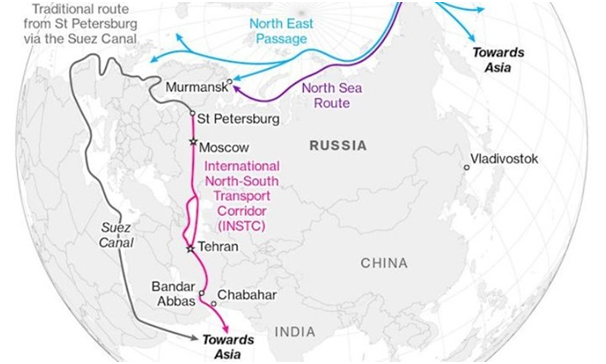
The shipping and rail networks via Iran and an Arctic sea passage could
strengthen Moscow’s pivot toward Asian powerhouses China and India and away
from Europe. They have the potential to
embed Russia at the heart of much of international trade even as the US and
its allies are trying to isolate President Vladimir Putin over the war. The
routes could cut 30%-50% off transit times compared to the Suez Canal and avoid
security problems plaguing the Red Sea as Houthi rebels attack international
shipping over Israel’s war against Hamas in Gaza. Iran’s missile and drone
strikes aimed at Israel have added to the regional turbulence.
While the US and its Western
allies are shunning the Russia-backed routes despite potential cost savings,
major Asian and Gulf economies have shown interest.
Russia is preparing to invest more than $25 billion to upgrade the route
via Iran and improve facilities along the Russian Arctic shoreline, including a
fleet of domestically manufactured ice-breakers. It also plans to patrol the
NSR route with a network of drone bases, Izvestia newspaper reported, citing an
unidentified Defense Ministry official.
Russia issued a 1.3 billion euro ($1.4 billion) loan to Iran last May to
build a vital missing rail link that will stretch 162 kilometers (101 miles) to
connect the city of Rasht along the Caspian Sea coast to Astara on the border
with Azerbaijan. Once completed, the railway will allow cargo supplies from St.
Petersburg to Bandar Abbas, Iran’s main export port on the Persian Gulf.
“Its construction will allow us to create direct and uninterrupted
railway transportation along the entire length of the North-South route,” Putin
said during a videoconference with Iranian counterpart Ebrahim Raisi. “This
will help considerably diversify global transport flows.”
Transportation capacity along the north-south route, which includes a
longer rail link via central Asia and a Trans-Caspian Sea network, could
increase by 85% to 35 million tonnes a year by 2030, according to the Eurasian
Development Bank. It will connect Russia with Iran and India as well as
potentially the rest of South Asia, the Persian Gulf and Africa. Last August,
Russia sent its first direct cargo train to Saudi Arabia.
“If the other routes are interrupted, this one will continue working
because it’s sanctions-proof,” said Nikita Smagin, an analyst at the Kremlin-founded
Russian International Affairs Council. “That’s the main idea.”
Driven by Russian oil sales and purchases of electronics, industrial
equipment and cars, trade with China hit a record $240 billion in 2023, more
than double the $108 billion reached in 2020. Trade with India grew to almost
$64 billion last year, versus around $10 billion three years earlier, as New
Delhi’s purchases of Russian oil have soared since the war in Ukraine began.
Russia’s growing trade with China is already spurring the Kremlin to
spend billions to upgrade its vast eastern railroads to expand capacity on the
Trans-Siberian and Baikal-Amur Mainline by 2030.
In January, Putin attended a keel-laying ceremony for the fifth of seven
nuclear-powered icebreakers Russia is building for service on the Northern Sea
Route, calling the fleet “an enormous
competitive advantage” for the country.
At the launch of two earlier vessels in November 2022, Putin said the
ships would “help Russia more fully unlock its export potential and establish
efficient logistics routes, including to Southeast Asia.”
India meanwhile is investing in Chabahar, the only Iranian port with
direct access to the Indian Ocean, after getting a waiver from US sanctions.
The Russian-backed rail connection via Iran opens the way to central
Asia — including crucially Afghanistan — and “offers a shorter route to
Europe,” said Vaishali Basu Sharma, a former consultant at India’s National
Security Council Secretariat.
“Emerging markets are finally
breaking free from the hegemony created by developed countries,” she said.